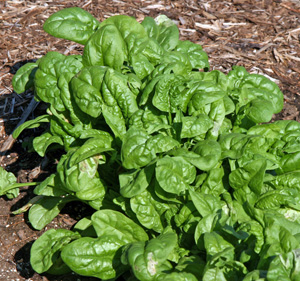
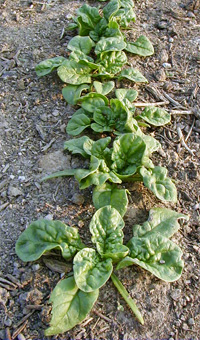
The cartoon character Popeye attributed his great strength to eating spinach — maybe justifiably, since this leafy vegetable has a very high iron content. Spinach (Spinacia oleracea) is a hardy annual related to beets and Swiss chard that has been used by humans for a long time. Native to southwest Asia, it was first cultivated in Persia (Iran) over 2000 years ago and used by the Chinese in the 6th century. Arabs brought it to the Spanish around the 11th century and it had spread to the rest of Europe by the 14th century. It was brought to the Americas with the early colonists. The plant grows a rosette of dark green leaves but under warm temperatures and long daylength it bolts or goes to seed. The leaves may be eaten fresh or cooked.
Varieties of Spinach
There are two basic types of spinach with either smooth leaves or crinkly (savoy) leaves. The smooth types are normally grown for freezing and canning because they grow faster, yield more and are easier to clean.
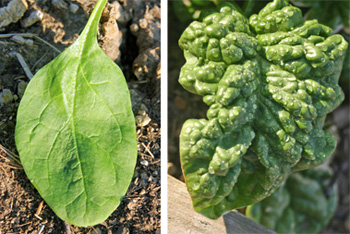
The savoy types are preferred for the home garden and fresh market use because they look and taste better, keep longer and have less oxalic acid (which can interfere with the utilization of calcium or magnesium in the diet) than smooth leaf types. Semi-savoy types have lightly crinkled leaves.

Some of the newer varieties of spinach, such as ‘Indian Summer’ and ‘Olympia’, are slow bolting (seed-stalk development is slow even as day length increases), so these may be desirable for summer crops. Older varieties without this trait are best used for spring or fall plantings. The old rule of thumb was that prickly-seeded varieties were best for spring and fall, while round-seeded varieties were better for summer but this is no longer true as new varieties of slow-bolting, round-seeded types have been developed.
Some commonly available cultivars include:
- ‘Avon’ is a semi-savoy type for early spring planting. It has large, slightly crinkled, dark green leaves and has resistance to blight and mildew. (44 days to harvest).
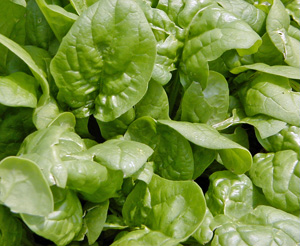
‘Bloomsdale Long Standing’ spinach. - ‘Bloomsdale Longstanding’ is an older variety and one of the best tasting but has no disease resistance. It grows erect, with thick, very crinkly, glossy dark green leaves. It is good for late spring and early summer harvest, and will often overwinter with mulching. Other Bloomsdale types have been selected for earlier maturity and slow bolting. (48 days to harvest)
- ‘Melody’ is an All-America Selection winner (1977) that has tender, dark green, lightly crinkled leaves with superior flavor. It has tolerance to downy mildew races 1 and 2 and is resistant to cucumber mosaic virus. It grows quickly to a large plant, so is good for spring or fall plantings. (42 days to harvest)
- ‘Olympia’ has smooth, dark green leaves. It is very fast-growing but is also very slow to bolt, so is good for spring and early summer planting. It is resistant to downy mildew races 1, 2, and 3. (46 days to harvest)
-
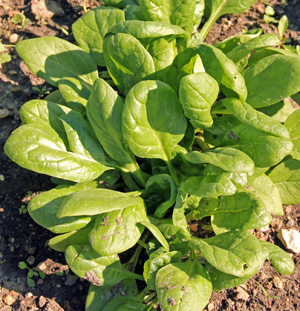
‘Space’ spinach.
‘Regal’ is a semi-savoyed variety suited to dense plantings for baby leaves. It is resistant to downy mildew races 1-7. (30 days to harvest) - ‘Space’ is another smooth-leaved, bolt-resistant variety suitable for later plantings. It has a thick leaf that doesn’t bruise as easily as some types, even when small. Good for both baby spinach and full grown plants. (39 days to harvest)
- ‘Tyee’ is a fast-growing savoy type with thick dark green leaves, similar to Melody. The upright growth habit helps produce cleaner leaves. It is very slow to bolt and is resistant to downy mildew races 1 and 3. (39 days to harvest)
Varieties with resistance to blue mold were developed at the UW-Madison in the late 1950’s – including ‘Badger Savoy’ and ‘Wisconsin Bloomsdale’ – but these do not seem to be available anymore.
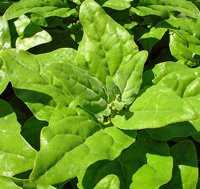
New Zealand spinach (Tetragonia tetragonioides or previously T. expansa) is a completely different plant in a different family. Native to New Zealand, this tender annual grows weak, spreading stems 2-4 feet long. Its dark green leaves are smaller and fuzzier than regular spinach but when cooked are virtually indistinguishable from the real thing. However, it grows best under long warm days so it will produce all summer long when regular spinach turns bitter or goes to seed. Its culture is the same as for regular spinach, except it should be planted
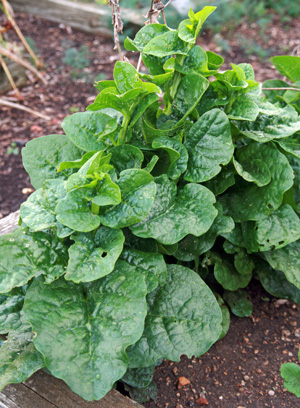
1-2 inches apart after the soil is warm and the multiple seedlings from each seed cluster should be thinned when the seedlings are large enough to handle. Pinch off the ends of the stems of large plants to encourage new growth.
There are a number of other tropical plants that are spinach substitutes, including Malabar spinach (Basella alba), water spinach (Ipomoea aquatica), and Chinese or African spinach (Amaranthus gangeticus).
Planting
Plant spinach from seed when conditions are suitable. Spinach seed does not remain viable for very long, so purchase seed packaged for the current year.
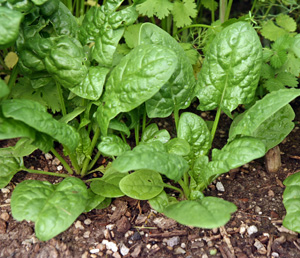
You may be able to keep spinach seed under optimal storage conditions for a couple of years but germination rates will probably be much lower.
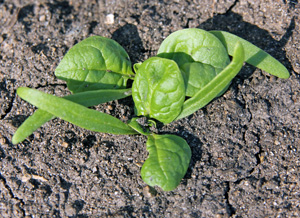
Spinach is a cool-season crop that should be planted in early spring, about 4 weeks before your area’s average date of last frost. Ideal spinach weather is 50-60°F. Spinach does best in well-drained soil rich in organic matter and will tolerate partial shade. Plant seeds 1-4 inches apart and about ½ inch deep. If you use the closer spacing, thin when the leaves touch, when the plants are about 2″ tall, using the tender leaves for salad greens.
Make sequential plantings about 2 weeks apart to continue harvesting spinach through the summer. Choose bolt-resistant varieties for later plantings. But even slow bolting types will not remain vegetative for very long, so each planting’s productive time will be short. Leaf quality declines when the reproductive cycle begins with seed-stalk formation.
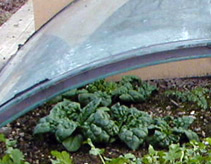
A fall crop often tastes better than the spring crop because the temperature cycle of warm to cool weather is more predictable. Plant the fall crop in mid-August for a late-September (or later) harvest. Extend the season by covering the plants during really cold nights or grow in a cold frame.
You can also try a “winter” crop, planted in late September, that will grow a little before going dormant for the winter. Alternatively, just cut off the leaves of the plants of your fall crop, leaving the roots and growing point intact. These plants may overwinter to grow a new crop of leaves in the spring. In colder areas or severe winters, covering the plants with mulch may enhance their survival. Some varieties, such as ‘Bloomsdale Longstanding’, are hardier than others, and are more likely to survive the winter.
Culture
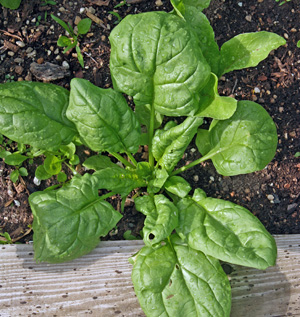
Grow spinach in rich, moist soil with good soil aeration. Poor, dry soil only encourages spinach to go to seed. It does best with uniformly moist soil, but try to avoid splashing water so the leaves won’t get so dirty. You can mulch around the plants to help retain moisture and keep soil off the leaves.
Spinach is a weak competitor, so keep the spinach bed weed-free. Pull tiny weeds or cut off larger ones at ground level to avoid injuring the shallow roots of the spinach plants.
Spinach is a heavy feeder. Fertilize before planting and at midseason to stimulate growth and yield. This is more important in spring when nitrogen is less available to plants in the cold soil. Apply a sidedressing when plants are about 2 inches tall. Use about ¼ pound of 5-10-5 fertilizer per 10 feet of row. If the leaves begin to yellow, add additional nitrogen.
Pest Management
There are few insects or diseases that bother spinach. Aphids may occasionally infest plants and spinach leafminer may be problematic in some areas. Aphids can be controlled by removing infested leaves or with chemicals if numerous. Minor infestations are often destroyed by a variety of natural enemies, such as green lacewings, lady beetles and parasitic wasps. Aphids may also be washed off the leaves with a vigorous stream of water.
Spinach leafminer is a fly that lays its eggs on the undersides of the leaves. The maggots burrow into the leaf and create conspicuous trails as they eat their way through the leaf. Remove leaves with eggs or mines but don’t spray chemicals since they are ineffective once the insect is inside the leaf. To prevent leaf miner damage put floating row cover on after thinning. Use supports, such as hoops, to keep the fabric off of the plants. Unlike other plants which tolerate row cover placed directly on the plants, the tender spinach leaves can be abraded if the fabric brushes back and forth in windy conditions.
Slugs can also be a problem in very moist situations. Do not mulch around the plants.
Spinach is susceptible to rust but most varieties are rust resistant. Occasionally leaf spots, either Cercospora leaf spot or Anthracnose, may develop on the upper sides of the leaves, then fall out to form holes. Fungicides will control these diseases. Choose resistant varieties if downy mildew is a problem in your garden.
Harvesting
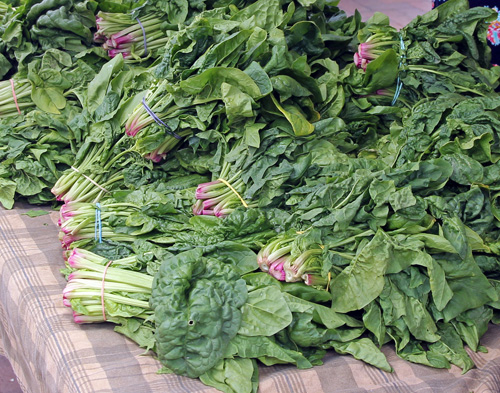
You can remove individual leaves periodically starting when the plants have at least 6 true leaves or harvest the entire plant at maturity. This is probably the best harvesting method in the spring or when a central stalk begins to appear. Cutting the plants off at the soil line will keep the harvested leaves cleaner than if the whole plant with its roots is removed. In the fall, removing the outer leaves only will allow the plant to continue to grow and produce more for continued harvest.
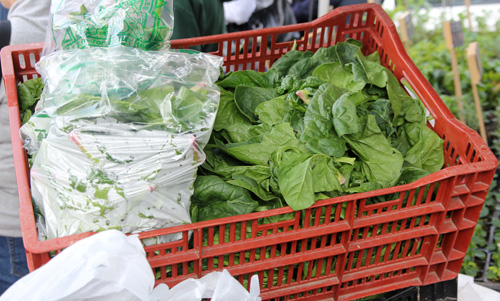
Wash the leaves thoroughly in plenty of water to eliminate the grit that sometimes sticks to the leaves, especially the crinkled types.
Fresh spinach can be refrigerated up to one week. The leaves can also be frozen, canned or dried.
– Susan Mahr, University of Wisconsin – Madison





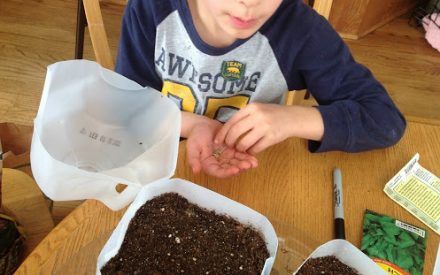 Seed Starting
Seed Starting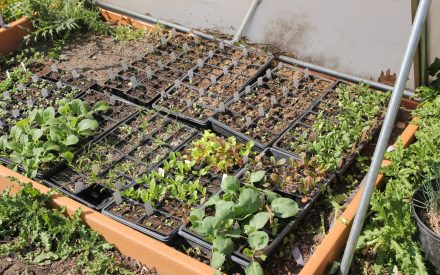 Growing Vegetables at Home: Questions and Answers
Growing Vegetables at Home: Questions and Answers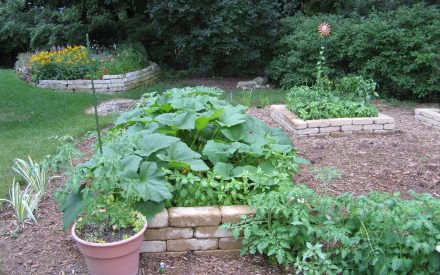 Growing Vegetables in Containers
Growing Vegetables in Containers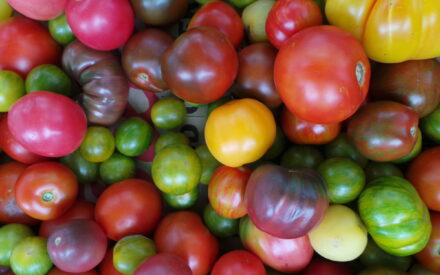 Homegrown Tomatoes for Wisconsin
Homegrown Tomatoes for Wisconsin


